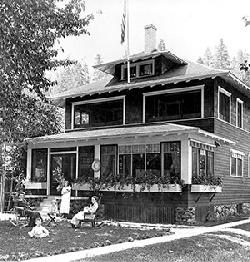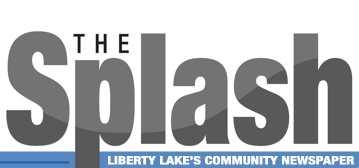 |
| Photo courtesy of Liberty Lake Historical Society |
The striped roller shades on the right side of the F.O. Berg summer home on Lilac Lane, circa 1920, were most likely from the families business, F. O. Berg Tent and Awning Co.
|
|
|
|
|
History: Beachside lots attracted buyers to lake
1/28/2015 1:27:52 PM
Wicomico Beach established in early 1900s
By Ross Schneidmiller
Liberty Lake Historical Society
Upon retirement from active business in early 1907, Roderick MacKenzie, Liberty Lake's first modern day visionary and developer, sold his entire west-side holdings to the Palouse Land Company. This included the hotel that bore his name as well as 806 acres. Prior to selling those interests, he granted a railroad right of way to the Inland Empire Railway Company.
Aware of the Railway's plans to run a spur-line into the lake, the land company purchased 1,000 acres in total. Upon this land they planned to build Spokane's greatest and most popular summer colony. The tracks connecting Liberty Lake Junction to the shoreline were completed and ready for the inaugural trains on June 12, 1907.
About a month later the land company began an aggressive newspaper campaign.
"Pitch Your Tent At Liberty Lake," read the headlines in the July 10 issue of The Spokesman Review. It would be another three weeks before the company would begin selling lots, yet they were already trying to motivate potential buyers to the lake.
The summer colony was named Wicomico Beach. Pronounced "We-co-me-co," the name was made up but ads proclaimed it was an Indian word meaning, "Where Homes are Building."
The MacKenzie Hotel was newly furnished and renamed the Wicomico Inn. They declared that its first-class accommodations and dining room made Wicomico Beach one step closer to becoming the ideal summer resort of Spokane. It opened on Aug. 1, the same day lots became available for sale. Located inside the inn was the sales office for the development.
The targeted buyers were the Spokane business community. Ad after ad heralded the benefits of getting out of the city during the summer: a refuge for her people during the heated season with all the conveniences and none of the inconveniences of the city. It was only 40 minutes from Spokane by electric train. The businessman could attend to business every day in the city, and after the day's work was over come home to Wicomico and enjoy the rest he would not otherwise get. Pure spring water would be piped to every lot. A concrete dam and reservoir was built to collect the water from three large springs. The water was used both domestically and for watering lawns and gardens. The homes would have the conveniences of electricity, telephones and sewer just like the city. But unlike crowded busy cities, restrictions were in place insuring privacy and tone.
The development comprised some three hundred lots platted in four tiers all facing the lake. The size of the lots varied somewhat with the curve of the beach, but most of them measured about 50 x 120 feet. Because the ground rose as it receded from the beach, most lots had a view of the lake. Access to the lake was afforded all lot owners. However, access was limited to the purposes of "bathing, boating and fishing." This gave the land company the ability to restrict activities they felt detracted from their development and hindered the tone of a relaxing, family-friendly environment.
Building restrictions prevented the erection of shacks or unsightly structures. One was not obligated to build, however, until the buyer desired. In the meantime, the owner was allowed to camp in a tent on the lot.
The development company did not have the infrastructure in place for building to commence until 1909. Buyers took advantage of the clause concerning tents- erecting some that were quite substantial. All 25 of the beachside lots on Saltese Avenue, known today as Lilac Lane, were sold by 1910. In that same year, 20 of those 25 lots either had a home, was under construction or in the planning stages. Within a few years several more of the primary lots sold and building commenced. It would take several years for the secondary lots to build out.
Wicomico Beach still exists. All the summer homes except for one have become year round residences. The developer's vision of a commuter colony became a reality and remains so today.
Ross Schneidmiller is president of the Liberty Lake Historical Society.
Did you know?
The owners of the Palouse Land Company, David Ham and Wilbur Yearsley, reorganized their business in September of 1907 adding D. Ryrie and Shirley Philbrook to the firm renaming it Ham, Yearsley, Ryrie & Philbrook. By 1909 Philbrook was gone and in 1910 the name Liberty Lake Land Company, a corporation of the remaining three owners, was used in conjunction with the development.
By 1910 the land company platted the First and Second Acre Additions to Wicomico Beach on land they owned west of the first plat. This added the potential to purchase tracts from 5 to 40 acres.
As more cottages were built, the spring water system became inadequate. To address the problem, a second water system was added pumping water from the lake. After this was installed, the spring water system was used only for drinking and cooking purposes.
The electrical system for Wicomico Beach residences was taken over on May 1, 1931, by the Washington Water Power Company which today operates as Avista Utilities.
The original sidewalk on Wicomico Beach was made of wood.
In addition to individuals, a number of Spokane fraternal organizations and clubs purchased lots for the purpose of building clubhouses.
Advertisement

|
